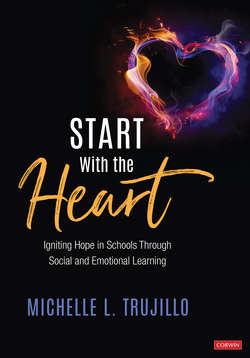Читать книгу Start With the Heart - Michelle L. Trujillo - Страница 14
Meeting People Where They Are
ОглавлениеWe have to start by meeting people where they are. Bryan Rhoades provided my first lesson in this regard. In middle school he was diagnosed with Friedreich ataxia, a type of muscular dystrophy that causes progressive damage to the nervous system. It manifested itself in Bryan’s body by causing constant jerking movements of his arms and legs. I was in my first year as an adapted physical education teacher when I met Bryan. I was inspired by this student who was bound and determined to do things as he did them before this debilitating disease began to take control of his body. I have many memories of Bryan, who imprinted himself upon my heart from the moment I met him. With unbridled enthusiasm, he told me he was an amazing football player and someday he was going to play for his beloved Denver Broncos.
Though I was his teacher for only three years, he and I remained in each other’s lives. His mom and aunt were on their own, raising Bryan and his little brother. They worked hard for these boys, trying to make ends meet, but they needed extra support sometimes, and my husband and I found ourselves helping out occasionally. Toward the end of Bryan’s life, just a year after he graduated from high school, I cherished time with him as he recalled fun memories from the hospital bed set up in his living room. He laughed out loud when he reminded me of the time I let him ride a bicycle through the middle of town. His balance was so poor that he had to go as fast as he could to keep the bike upright, all the while knowing he did not have the physical ability to stop the bike on his own. He teased me about how I could barely keep up with him as I ran alongside him to prevent him from crashing. I must have been crazy! Oh, but it was worth it to hear his laugh and see the joy in his face that came from the feeling of freedom as the wind touched his face. The independence of riding on his own gave Bryan a reprieve from his present reality, and I was so grateful to be there with him.
In my naiveté as a young teacher, I only knew to meet Bryan right where he was: stubborn, convicted, and fighting his disease with all his might! He taught me to see beyond his disability, beyond the seventh-grade student who didn’t care much about his school work. He helped me to see his heart; he invited me, in attitude and spirit, to meet him there and to provide opportunities for him to accomplish small tasks and achieve what seemed to be impossible. Somehow, some way, I understood that although academic achievement was important to his life as a student, it would have to take a back seat to Bryan’s need for independence, his desire to be the active kid he had always been, for just a bit longer.
Even today, my memories of Bryan influence my motivation to encourage educators to meet all colleagues and students where they are; to see all of them for the people they are as human beings, knowing that we may not comprehend the reason behind someone’s way of being. We must attempt to see past a disconcerting behavior in order to seek an understanding of what happened in that person’s life to cause such a response. This doesn’t mean that we neglect to correct the behavior or disregard expectations for positive conduct, but such consequences or high expectations will be meaningless if we remain unaware of the catalyst that prompted the undesirable conduct.
Our students provide us with plenty of opportunities to put this quest for understanding into practice. Our youngest learners, especially, can test our patience because they frequently resort to “acting out” behavior when they don’t have the words to articulate why they are upset or frustrated. Students in middle or high school may be capable of explaining their outbursts or negative actions, but they don’t always want to share or verbalize. They may have protective factors in place, due to trauma, fear, or embarrassment, that prevent us, as educators, from being enlightened to the the story behind their behavior. As a result, it can be challenging for us to connect with these students.
In fact, the students we tend to have the greatest difficulty building relationships with, the ones who tend to be our repeat offenders with regard to discipline issues, disrespect, bullying, and the like—as well as the students who are often targets of such behavior—are frequently kids who live with the reality of adversity. Some act angry, tough, and self-righteous; others appear apathetic or rude. Author and educational leader Eric Jensen (2009) writes, “Behavior that comes off as apathetic or rude may actually indicate feelings of hopelessness and despair” (p. 29). Think about it. We see this behavior in our students. Here’s a challenge for you: Try to see behind the façade, to determine what they might be feeling and thinking and find out why, even when they push you away. If we are persistent and accepting, we will connect with the hearts of our students. In doing so, we will set the foundation for trust that allows our students to feel seen and heard, which ultimately helps them know that they are people whom we care about and in whom we find worth.
